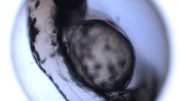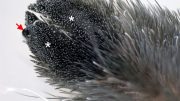
Scientists gain understanding of mechanisms that determine growth patterns of tiny hair cells within the ear.
A study of the genetic make-up of zebrafish has provided brand new insights into the cause of congenital hearing disorders in humans.
A team including scientists from Cardiff University has identified how specific genes can dictate the patterns of the tiny cells — so-called hair cells — within our ears that allow us to hear and process sounds.
Genetic factors are thought to cause more than 50 percent of all incidents of congenital hearing loss, with many attributed to the misalignment or damage of tiny hair cells.
These hair cells exist in their thousands within the cochlea and are ‘tuned’ to respond to different sounds based on pitch or frequency. This is due to a collective property called ‘planar polarization’, or the orientation in which the tiny hairs are laid out. When sound enters the ear, the hairs change the sound vibrations into an electrical signal that is sent to the brain, allowing us to recognize it.
Using zebrafish as a proxy, scientists have shed light on how changes to specific genes alter the coordinated direction that these cells are laid out.
The findings have been published in the journal Nature Communications.
Zebrafish have very similar hair cells along their body, within the so-called lateral line organ, which they use to read pressure differences in water. Critically, zebrafish can regenerate these hairs when they are damaged, providing scientists with an ideal testbed to understand when things may go wrong.
Moreover, due to the inaccessibility of the inner ear, studying the alignment of hair cells in humans is extremely challenging.
In their study, the team investigated the genes underlining two signaling pathways – PCP and Wnt – that are present in both humans and zebrafish and are known to affect the way in which hair cells coordinate their orientations.
By systematically switching these genes off in the zebrafish, the team was able to study the multiple effects that this could have on hair cell direction.
This was made possible using new statistical characterizations developed at Cardiff University, which enabled the scientists to measure the types of hair cell patterns that would be created, for instance being highly aligned in rows, not aligned, or aligned in circular structures.
Results showed that not only could the regularity of the hair cell pattern be destroyed, producing a random hair cell direction, but certain alterations to the genes could lead to the hair cells having circular or spiral patterns.
First author Joaquin Navajas Acedo, Student at the Graduate School of the Stowers Institute for Medical Research, said: “The lateral line of zebrafish represents a unique tool to study this problem in particular, because of its accessibility and size. We are just beginning to understand the complex regulatory mechanisms behind this exciting process, and we hope more people start using this system to tackle the problem.”
Co-author of the study Dr. Thomas Woolley, from Cardiff University’s School of Mathematics, said: “The big result is that we better understand what influences hair cell directionality and, equally, what may be going wrong in humans. These insights provide new directions through which we can tackle congenital hearing problems.”
The study involved scientists from Cardiff University, the Stowers Institute for Medical Research, and the Fred Hutchinson Cancer Research Center.
Reference: “PCP and Wnt pathway components act in parallel during zebrafish mechanosensory hair cell orientation” by Joaquin Navajas Acedo, Matthew G. Voas, Richard Alexander, Thomas Woolley, Jay R. Unruh, Hua Li, Cecilia Moens and Tatjana Piotrowski, 5 September 2019, Nature Communications.
DOI: 10.1038/s41467-019-12005-y









Be the first to comment on "New Breakthrough on Human Hearing Disorders From an Unlikely Source: Zebrafish"